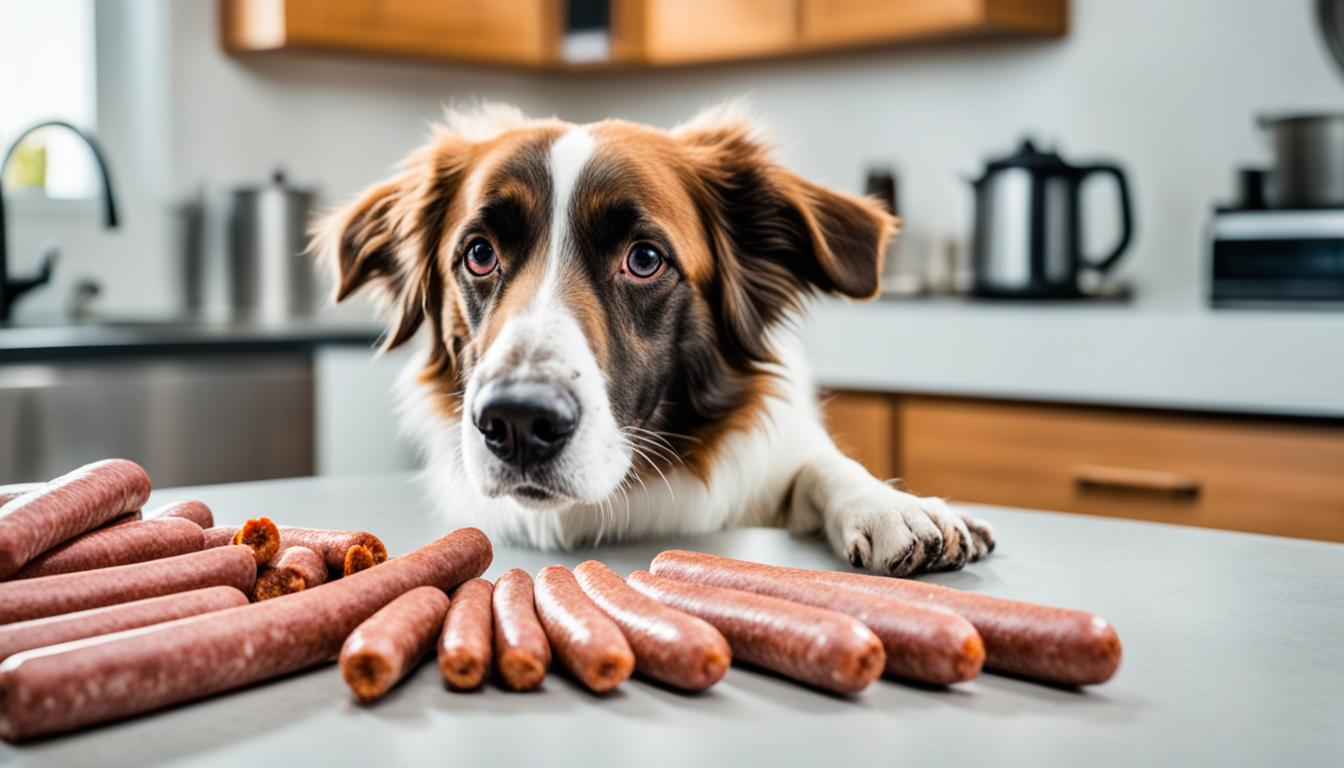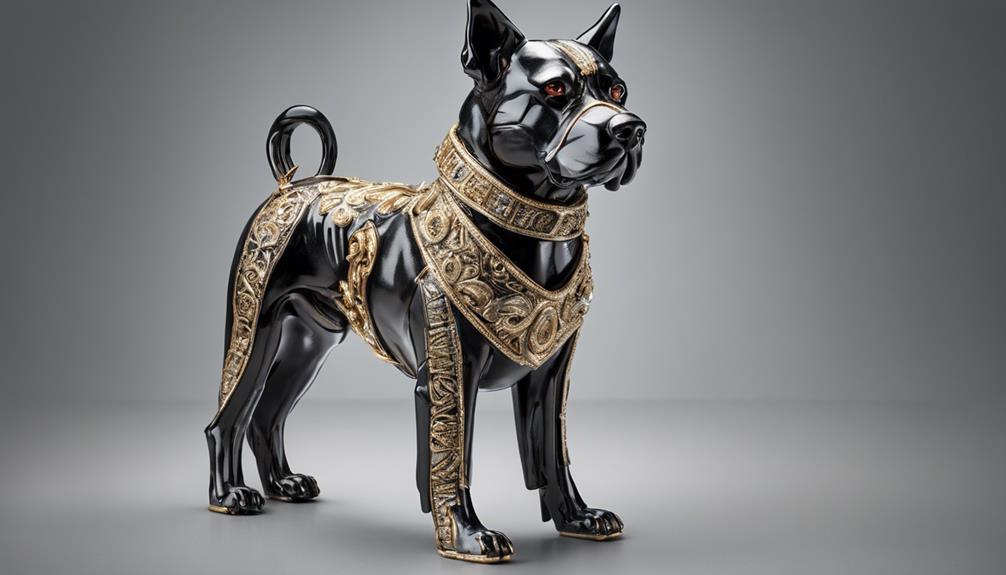Did you know that sausages, whether they are raw or cooked, can be dangerous for dogs?
Feeding your furry friend a small piece of sausage may seem harmless, but the truth is that sausages contain ingredients that can cause serious health issues in dogs. High levels of fat, sodium, and seasonings like garlic and onion can lead to pancreatitis and other digestive problems.
If you’re wondering about the safety of feeding dogs raw sausages, it’s best to avoid it altogether. Fortunately, there are plenty of healthier protein options that you can offer your canine companion.
Key Takeaways:
- Feeding dogs raw sausages, whether they are cooked or raw, is not recommended.
- Sausages contain ingredients that are harmful to dogs, such as high levels of fat, sodium, garlic, and onion.
- Instead of sausages, opt for healthier protein options like plain chicken, turkey, salmon, beef, or lamb.
- If your dog has consumed sausage and shows distressing symptoms, contact your vet for guidance.
- Consult your vet to ensure new foods are safe and appropriate for your dog’s specific needs.
Are Bratwurst Safe for Dogs to Eat?
In this section, we will discuss whether bratwurst, a German-style sausage, is safe for dogs to eat. It’s important to know what foods are safe for our furry friends to prevent any potential health issues.
Bratwurst, like other sausages, should be avoided when it comes to feeding dogs. While it may be tempting to share this delicious treat with your canine companion, it can pose certain risks to their health.
Bratwurst often contains added spices like onion or garlic, which are toxic to dogs. These ingredients can lead to serious health problems, including gastrointestinal upset, anemia, and even organ damage. Furthermore, the high-fat content in bratwurst can contribute to obesity and pancreatitis in dogs.
It’s best to err on the side of caution and steer clear of feeding bratwurst to your dog. Instead, opt for safer protein options that are suitable for canine consumption.
The Dangers of Onion and Garlic for Dogs
“Onion and garlic are members of the Allium family and are toxic to dogs. These ingredients can cause damage to their red blood cells, leading to anemia and other health complications. As a responsible pet owner, it’s crucial to keep these foods away from your furry friend.”
While you may find it challenging to resist those adorable puppy-dog eyes, it’s important to prioritize your dog’s health and well-being. They rely on us to provide them with a balanced and safe diet.
Instead of sharing bratwurst, consider offering your dog healthier protein options such as plain chicken, turkey, or fish like salmon. These alternatives provide the necessary nutrients without the risks associated with sausages.
To help you make an informed decision, here’s a simple comparison table highlighting the key differences between bratwurst and safer protein options:
| Bratwurst | Safe Protein Options | |
|---|---|---|
| Ingredients | May contain onion, garlic, and other harmful spices | Plain and unseasoned |
| Fat Content | High | Varies depending on the cut; can be tailored to your dog’s needs |
| Health Risks | Potential toxicity, gastrointestinal issues, obesity | Minimal, with proper portion control |
| Nutritional Value | Limited | Provides essential nutrients for dogs |
As you can see, bratwurst comes with a higher risk profile for dogs compared to safe protein options. It’s crucial to prioritize your dog’s health and make choices that will promote their well-being.
By avoiding bratwurst and opting for safer alternatives, you can ensure your furry friend enjoys a tasty and nutritious diet without compromising their health.

What to Do If Your Dog Ate Sausage
If your dog has eaten a small piece of sausage, monitor them for any signs of digestive upset, such as vomiting, diarrhea, lack of appetite, and lethargy. In most cases, a small nibble of plain sausage may not cause serious harm.
If your dog has consumed a large amount of sausage or shows distressing symptoms, it’s important to contact your vet for guidance. They can provide further advice based on your dog’s specific situation.
Now let’s take a look at a relevant quote:
“If your dog has eaten a large amount of sausage or is showing concerning symptoms, it’s crucial to seek veterinary advice. They will be able to assess the situation and provide appropriate guidance.”
If you’re unsure about how much sausage your dog has consumed or are concerned about their well-being, don’t hesitate to reach out to your vet. They are the best resource to determine the necessary course of action. It’s always better to err on the side of caution when it comes to your furry friend’s health.
Here are some things to keep in mind:
Signs of Digestive Upset:
- Vomiting
- Diarrhea
- Lack of appetite
- Lethargy
Keep a close eye on your dog and observe their behavior. If they exhibit any of these signs, it’s essential to seek professional advice as soon as possible. Your vet will be able to provide guidance tailored to your dog’s specific needs and determine if any further action is required.
Now, let’s move on to a table outlining the recommended steps to take if your dog eats sausage:
| Actions to Take | Explanation |
|---|---|
| Contact your vet | Your vet is the best person to provide guidance based on your dog’s specific situation. |
| Monitor for symptoms | Observe your dog for signs of digestive upset and notify your vet if any concerning symptoms arise. |
| Follow vet’s advice | Implement any recommendations or treatments suggested by your vet to ensure your dog’s well-being. |
Remember, each dog is unique, and the severity of the situation may vary. Consulting your vet is crucial for accurate advice and appropriate measures to be taken.
Safer Alternatives to Sausage for Dogs
While sausage is not safe for dogs to eat, there are plenty of healthier alternatives to consider. We understand that you want to provide your furry friend with tasty and nutritious options that won’t compromise their health. Here are some dog-friendly protein alternatives to sausage:
- Plain Chicken or Turkey: Lean sources of protein, these meats can be cooked and served to your dog without any seasoning, skin, or bones. They offer a similar texture and flavor to sausage without the harmful ingredients.
- Cooked Vegetables: Carrots and green beans are excellent choices for adding more nutrients to your dog’s diet. These cooked vegetables are low in calories and provide essential vitamins and minerals.
- Specially Made Dog Treats: There are dog treats available in the market that are formulated to resemble sausages. These treats are made with safe and dog-friendly ingredients, ensuring your dog can enjoy a sausage-like experience without the risks.
When introducing new foods to your dog, it’s always important to consult with your vet. They can provide guidance based on your dog’s specific needs and ensure that the alternatives you choose are safe and suitable for their health.

Remember, a well-balanced diet is crucial for your dog’s overall well-being. By opting for safer alternatives and consulting with your vet, you can provide your beloved companion with delicious and nutritious options that will keep them healthy and happy.
The Dangers of Feeding Dogs Raw Meat
Feeding dogs raw meat comes with several dangers. Raw meat can be contaminated with bacteria such as E. coli, Salmonella, and Listeria, which can make both dogs and their owners sick. Raw meat may also lead to nutritional deficiencies if not properly balanced, and bones in raw meat can pose a choking or obstruction hazard. Most veterinary organizations advise against feeding raw meat to dogs due to these risks.

Potential Benefits of Raw Food Diets for Dogs
When it comes to feeding our furry friends, there is an ongoing debate about the benefits of raw food diets. Advocates of raw food diets for dogs believe that it closely resembles their natural diet as carnivorous animals, which can lead to easier digestion and better nutrient absorption. These proponents argue that a raw food diet can provide several advantages for dogs, including:
- Improved Dental Health: Chewing on raw bones and meat can help keep a dog’s teeth clean and reduce the risk of dental issues like tartar and plaque buildup.
- Enhanced Digestive Function: Raw food diets typically contain fewer carbohydrates and fillers, which may promote healthier digestion in dogs.
- Healthy Skin and Coat: The high omega-3 fatty acid content found in certain raw foods, such as fish, may contribute to a shiny coat and reduce skin issues.
While these potential benefits sound promising, it’s important to note that scientific evidence supporting raw food diets for dogs is limited. The risks associated with feeding dogs raw meat, such as bacterial contamination and nutritional imbalances, often outweigh the potential benefits. Therefore, it’s crucial to consider these risks and consult with a veterinary nutritionist before deciding to feed your dog a raw food diet.

Although the concept of feeding dogs a raw food diet is appealing to some pet owners, it’s essential to prioritize our dogs’ health and well-being. Now, let’s delve into the potential risks of feeding dogs raw meat in section 7.
Risks of Feeding Dogs Raw Meat
Feeding dogs raw meat can pose several risks to their health and well-being. One significant concern is the potential for bacterial contamination. Raw meat can contain harmful bacteria such as E. coli, Salmonella, and Listeria, which can cause serious illnesses in dogs. These bacteria can not only make your furry friend sick but also pose a risk to human family members who come into contact with the contaminated meat.
Aside from the dangers of bacterial contamination, a raw meat diet may result in nutritional imbalances for dogs. It can be challenging to ensure a proper balance of nutrients when feeding raw food, potentially leading to deficiencies or excesses in certain vitamins, minerals, or essential nutrients. This imbalance can have detrimental effects on your dog’s overall health and well-being.
To illustrate the risks more clearly, here is a table comparing the potential dangers associated with feeding dogs raw meat:
| Dangers of Feeding Dogs Raw Meat | |
|---|---|
| Bacterial Contamination | Nutritional Imbalances |
|
|
Considering these risks, it’s important to carefully evaluate the potential hazards before deciding to feed raw meat to your dog. It’s crucial to prioritize your dog’s health and well-being by providing them with a safe and nutritionally balanced diet.

How to Mitigate Risks of Feeding Dogs Raw Meat
If you choose to feed a raw food diet to your dog, there are steps you can take to mitigate the risks involved. Here are some guidelines to ensure the safety of handling and feeding raw meat to your canine companion:
- Practice Excellent Hygiene: Wash your hands thoroughly with soap and water after handling raw meat. This helps prevent the spread of bacteria and reduces the risk of contamination.
- Disinfect Surfaces and Utensils: Clean and disinfect all surfaces, cutting boards, and utensils that come into contact with raw meat. This helps eliminate any potential bacteria left behind.
- Keep Raw Meat Frozen: Store raw meat in the freezer until you are ready to use it. This helps maintain its freshness and reduces the growth of bacteria.
- Thaw Safely: Thaw raw meat in the refrigerator or microwave, avoiding leaving it at room temperature for too long. This prevents bacteria from multiplying rapidly.
- Use Separate Dishes and Storage Containers: Keep raw meat separate from other food items. Use dedicated dishes and storage containers to avoid cross-contamination.
While these practices can help reduce the risks associated with handling and feeding raw meat, it’s important to note that raw food diets for dogs may still present other potential dangers, such as nutritional imbalances. Therefore, it is crucial to consult with a veterinary nutritionist to ensure the raw food diet is balanced and meets your dog’s specific nutritional needs.

Commercial Dog Food as a Safer Alternative
When it comes to providing balanced nutrition for dogs, commercial dog food is a safer alternative to raw meat. High-quality commercial dog food is specifically formulated to meet your dog’s nutritional needs and offers a wide range of options for different life stages and specific health conditions.
Unlike raw meat, commercial dog food eliminates the risks associated with bacterial contamination and ensures a balanced diet for your furry friend. By choosing commercial dog food, you can have peace of mind knowing that your dog is getting the necessary nutrients without compromising their health.
Consulting with your veterinarian is crucial in selecting the right commercial dog food for your dog. They can recommend the most suitable options based on your dog’s breed, age, activity level, and any specific dietary requirements they might have.
| Benefits of Commercial Dog Food |
|---|
| 1. Balanced nutrition |
| 2. Wide range of options for different life stages |
| 3. Formulated to meet specific dietary needs |
| 4. Convenient and easy to store |
| 5. Eliminates the risks of bacterial contamination |
We know that providing the best nutrition for our dogs is important. Choosing commercial dog food ensures balanced nutrition and reduces the potential risks associated with raw meat. Discussing your dog’s dietary needs with your veterinarian will help you make an informed decision about the right commercial dog food for your furry companion.

Quote:
“Commercial dog food eliminates the risks associated with raw meat, such as bacterial contamination and nutritional imbalances.” – Dr. Amanda Johnson, DVM
The Verdict on Feeding Dogs Raw Meat
When it comes to the controversial topic of feeding dogs raw meat, the veterinary opinion is clear – it is generally not advisable. The potential risks involved, including bacterial contamination and nutritional imbalances, outweigh any potential benefits. As responsible pet owners, we must prioritize our furry friend’s health and well-being.
Raw meat, such as chicken, beef, or fish, can be contaminated with harmful bacteria like E. coli, Salmonella, and Listeria. These bacteria not only pose a serious health risk to dogs but can also be transmitted to humans, putting the entire household in danger. Additionally, raw meat may lack the necessary nutrients, leading to nutritional deficiencies over time.
Instead of raw meat, we recommend opting for high-quality commercial dog food that is formulated to meet your dog’s specific nutritional needs. Commercial dog food undergoes rigorous quality control measures to ensure safety and balanced nutrition. It eliminates the risks associated with raw meat, providing peace of mind for pet owners.
The Benefits of Commercial Dog Food:
- Formulated for balanced and complete nutrition
- Varied options for different life stages and specific health conditions
- Rigorous quality control measures to ensure safety
- Easier to handle and store compared to raw meat
Feeding your dog commercial dog food not only eliminates the risks of bacterial contamination and nutritional imbalances but also provides convenience and peace of mind. However, it’s important to consult with your veterinarian to choose the right commercial dog food that meets your dog’s specific needs.

Remember, our furry friends rely on us to make the best decisions for their health and well-being. While it may be tempting to follow trendy diet trends like raw meat diets, it is essential to consider the advice of veterinary professionals. Feeding dogs raw meat is best avoided in favor of safer and nutritionally balanced alternatives like high-quality commercial dog food.
Conclusion
After considering the potential risks and hazards, it is clear that feeding dogs raw sausages or raw meat in general is not recommended. The presence of harmful bacteria, the potential for nutritional imbalances, and the various health issues associated with raw meat make it a risky choice for our furry friends. It’s crucial to prioritize our dogs’ health and well-being by opting for safer alternatives.
Lean protein options like plain chicken or turkey can provide the necessary nutrients without the risks associated with sausages or raw meat. These alternatives offer a balanced diet and are a much safer choice. Additionally, commercially prepared dog food is formulated to meet dogs’ nutritional needs, eliminating concerns about bacterial contamination or nutritional deficiencies.
Consulting with a veterinarian is essential to ensure we are providing our dogs with a safe and nutritionally complete diet. They can offer personalized guidance based on our dog’s specific needs, helping us make informed decisions about their dietary requirements. By choosing safer alternatives and seeking professional advice, we can ensure our beloved pets stay healthy and thrive.










